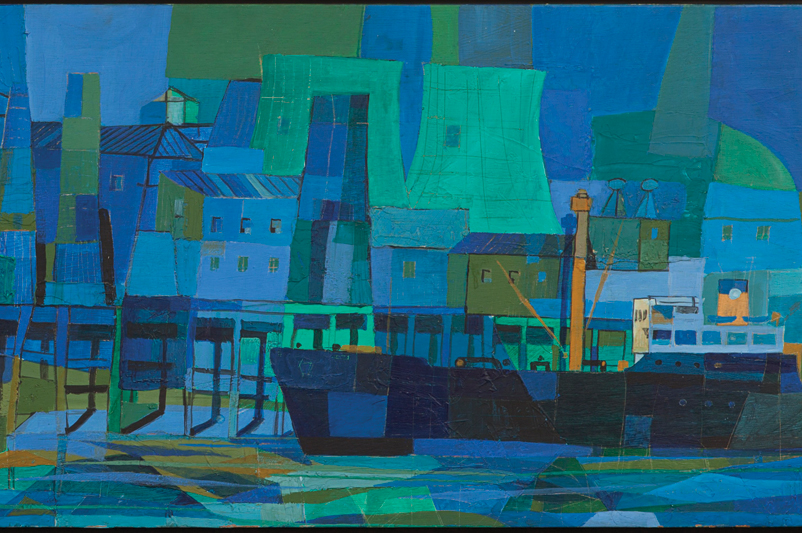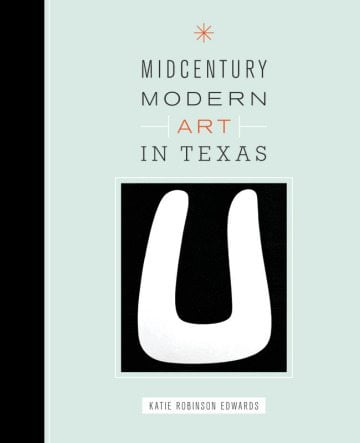
Katie Robinson Edwards’ Midcentury Modern Art in Texas Offers a Definitive Take on an Overlooked Era
A version of this story ran in the October 2014 issue.
Last year, oil-rich Angola made its debut appearance in the Venice Biennale, aka “the Olympics of the art world,” and in its first at-bat outhit 87 other countries to win the coveted Golden Lion award for best pavilion. That exhibit featured 23 photographs of found objects: broken chairs, a deflated soccer ball, a pint-sized liquor bottle, a single shoe, a satellite dish, an armless mannequin. Detritus, really, that Angolan photographer Edson Chagas had carried through the streets of Luanda until he found his ideal location to snap each photo. These 23 photos were then printed by the thousands on flimsy newsprint measuring 19 inches by 26 inches and stacked on wooden pallets that were spread across sumptuous rugs beneath opulent chandeliers among priceless antiquities within walls covered in embossed wallpaper and bearing Renaissance paintings by Tuscan masters in gilded frames. All in a 16th-century Venetian villa-turned-museum.

By Katie Robinson Edwards
University of Texas Press
392 pages; $60
The contrast between Chagas’ photographs and the context in which they were shown could not have been more stark. Compounding the disconnect was the fact that the antique chairs, benches and other objects in the Palazzo Cini were cordoned off behind stanchions and signs reading “Do not touch” and “Do not sit,” whereas the prints of Chagas’ broken chairs were free for viewers to take—an act of generosity on the part of the colonized contrasting with stern prohibitions from a former colonizer.
But I am not here to tell you about contemporary art from Angola.
Up a set of marble stairs from Chagas’ award-winning show, in the same Venetian villa, Angolan insurance company ENSA showcased 15 paintings and 11 sculptures from its collection, all created from 1982 to 2012. These 26 objects were distinctly Modernist—not contemporary—and different from the Chagas exhibit not just in terms of style, but in terms of encompassing context. They engage a completely different set of concerns, more formal, more rooted in one-of-a-kind objects, less experimental, less experiential, less immersive. These include surrealist paintings evocative of Magritte, cubist paintings evocative of Picasso, sculptures evocative of Henry Moore, and biomorphic paintings evocative of Yves Tanguy. (Let’s save the observation about how many Modernists were influenced by “primitive” art from Africa and elsewhere—making this manifestation of African Modernism a bit of an ironic return twice-removed—for another conversation.)
In the upstairs exhibition, there is no looking down at pallets on the floor to view mass-produced images of garbage on newsprint. No greedy tourists wrestling unwieldy sheets of rustling paper to take home as souvenirs. Just your standard, quiet, contemplative art exhibition.
Why am I still talking about art from a country that is only now officially joining the international art conversation, when I am supposed to be discussing a book about mid-20th-century Modern art from Texas? Because oil-rich Angola today makes for a fitting analogy to oil-rich, mid-20th-century Texas. It’s the new frontier!
Just a day or two before the Venice Biennale announced Angola’s Golden Lion award, Germany hosted a panel discussion outside its pavilion. One of the panelists was Simon Njami, a French curator of Cameroonian descent. At one point he spoke about his artist peers’ perception of his ancestral homeland when he was a young man.
“The problem with the Africans,” they told him, “is that, this contemporary thing, they don’t grasp it.”
So it was with Texan artists and art professionals in the middle part of the last century, and so it remains in discussions of Modernism to this day: Most people don’t think beyond New York and its Abstract Expressionists. Katie Robinson Edwards, curator of Austin’s Umlauf Sculpture Garden and Museum, has written a book, Midcentury Modern Art in Texas, to rectify that.
“The best Texas midcentury art,” Edwards asserts in Chapter 1, “is fully capable of profound visual communication, even fifty years after its creation and beyond the diffuse focus of an information-saturated global society.”
What follows is a thorough survey of artists both from Texas and working in Texas between the Texas Centennial (1936) and the mid-1960s, divided into chapters organized by region in roughly chronological order.
This reader is particularly pleased to have learned of Dorothy Hood, the painter from Bryan who studied at the Rhode Island School of Design and the Art Students League of New York, and who spent years in Mexico City in the company of Frida Kahlo, Diego Rivera, Rufino Tamayo, and the man who would become her husband, Bolivian filmmaker, actor, composer, dancer and musician José María Velasco Maidana. Her friend Pablo Neruda even wrote a poem for her show at Mexico City’s Gama Gallery. Hood eventually returned to Texas and taught painting at the Museum of Fine Arts, Houston.
I find myself drawn as well to the social consciousness of two of “The Dallas Nine,” a group of (more than nine) painters, sculptors and printmakers active in the 1930s and ’40s. The two are Alexandre Hogue and longtime director of the Dallas Museum of Art, Jerry Bywaters. Life magazine crowned Hogue “the artist of the U.S. Dust Bowl” for his deeply moving paintings depicting a dry and cracked Earth. Bywaters’ “Oil Field Girls” depicts a pair of women and their luggage on the roadside in a desert landscape, with billboards and oil derricks dotting the horizon and a plume of black smoke choking the sky.
I was also pleased to learn more about John Biggers, the famous muralist and founder of the art department at Houston’s historically black Texas Southern University. At a time when even his fellow African-American artists more typically turned to Europe for education and inspiration, Biggers availed himself of an opportunity to visit Benin, Ghana, Nigeria and Togo.
And finally, despite my environmentalist tendencies, I do sometimes find refineries beautiful—the way they can look like whole cities rising from the flatlands at night, their eternal flames topping the smokestacks. During the day, however, they look like the toxic tangles of pipe that they are—except in the hands of Herb Mears. In his 1956 painting “Cat Cracker/Refinery,” Mears, who was born in New York City and, alongside David Adickes, studied with Fernand Léger in Paris before coming to Houston, manages to render an oil refinery as something rich and dynamic, pulsating with a colorful rhythm.
There are so many more worthy artists I could mention here, but fresh discovery is the better part of this book’s fun, and the avenues for exploration are wide. At the end of this exhaustive survey of Lone Star artistry in the middle part of the last century, Edwards appends nearly 50 pages’ worth of artist biographies, another 50 pages of detailed endnotes, and an index, assuring that this volume will remain the definitive reference on its subject well into the future.
To support journalism like this, donate to the Texas Observer.


